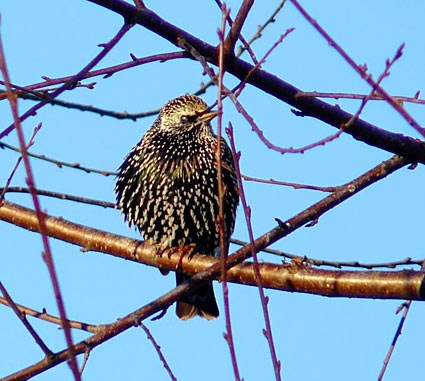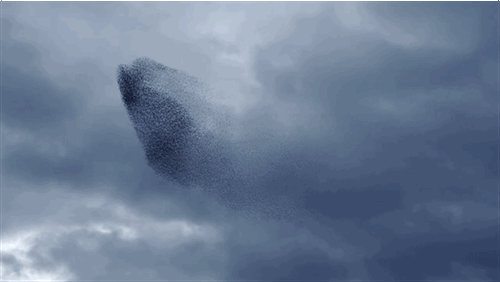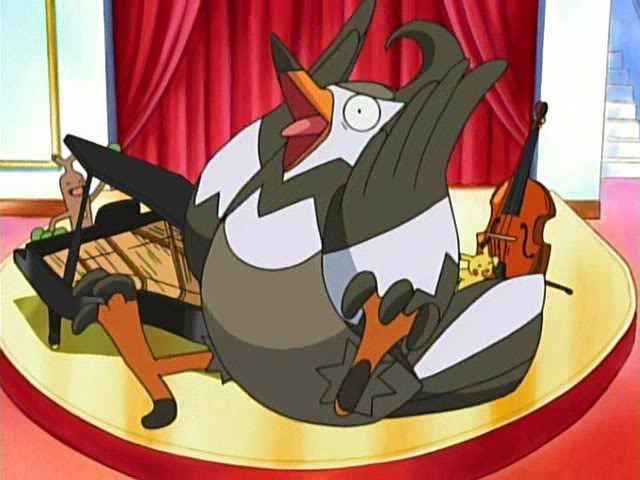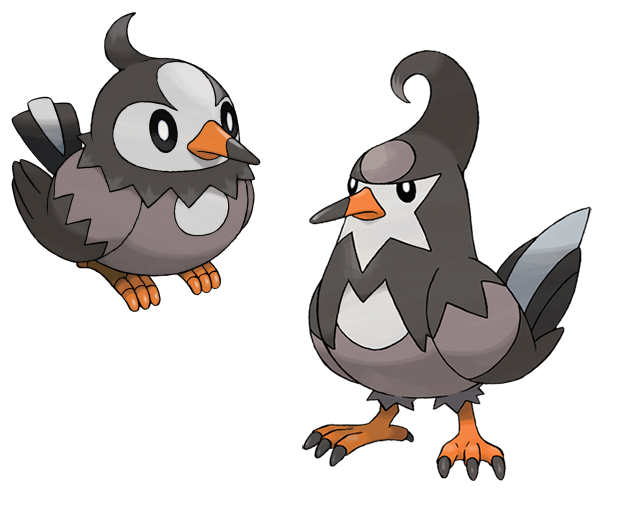This week’s Pokemon, Starly and Staravia*, were chosen because of something that I’ve been noticing for the past few weeks: there are a lot of birds chirping despite it being the dead of winter. Now, birds in winter is nothing new to me, but I don’t remember winter birds around my hometown being nearly as vocal as the birds I’ve been seeing around Camden. A few days ago I took some time to ID the birds, and was surprised to learn that they were European Starlings, an invasive bird which has some unusual behaviors and an even more unusual story behind their invasion.

Before I dive in, I want to point out that the Starly family isn’t based off the European Starling in particular. The starling family Sturnidae (based off Sturnus, the Latin name for starlings) has about 120 different species. I chose the European Starling to focus on because it’s the one that I see almost every day and it’s a pretty interesting bird. Bulbapedia (the Pokemon Wiki I use when writing these posts) suggests that the main inspiration is the White-cheeked Starling, which is native to East Asia and looks a lot more like Starly than a European Starling. That being said, the behavior I’m going to be talking about is found in most if not all starlings, including the White-cheeked Starling.
The most interesting behavior that starlings display is their flocking behavior. Flocking is nothing new, especially in the world of birds, but the flocking in European Starlings is somewhat different. Starlings flock in what are called murmurations, with hundreds to thousands of individuals flying together in some of the most amazing patterns imaginable. Words can’t do murmurations justice, so instead, you should just watch some videos. Seriously, go watch some videos, I’ll wait.

That’s incredible, right? For ornithologists, animal behaviorists, and bird watchers alike, murmurations bring up a lot of questions. Why do they all fly in unison like that? What causes the mesmerizing undulations of the flock? The first one is fairly easy. Many birds flock together in order to avoid predators**, with the basic idea being: more eyes, more chances to spot the predator, less likely to be eaten. In European Starlings, these predators are typically other birds, like hawks or falcons.
The other question baffled scientists for a long time. There were many hypotheses proposed, including one that suggested the birds were using a “biological radio” (i.e. telepathy) to communicate with one another. Ideas started changing with the rise of computers, which could model interactions between flocking birds. These models assumed a few key rules, namely that individuals will avoid colliding with each other, they will turn if nearby individuals turn, and they will remain in the flock. High speed video later helped to confirm these rules, with changes in direction moving through the flock like ripples from a stone dropped in a still pond.

Sadly, Starly and Staravia flocks are nowhere near as impressive as European Starling murmurations. Both Starly and Staravia are described as being weak and flocking for protection, but only Staravia flocks ever become particularly large (Starly bicker amongst each other in large flocks) but neither seem to have this incredible aerial behavior. In fact, the only other notable description given to Starly and Staravia is that they are quite noisey, something that I can attest to being true in starlings. But even their calls are less interesting than that of European Starlings, which are able to mimic the songs of other birds.
Now, as I pointed out earlier, Starly and Staravia are not based on the European Starling. That being said, while researching the European Starling I learned how it first came to the US, and I’d be remiss if I didn’t talk about it here. You see, you can blame their introduction on the most hated man in high school: William Shakespeare. OK, mabye that’s a bit harsh. The real villain here is Eugene Schieffelin, whose goal was to bring every bird ever mentioned in Shakespeare’s works to America.

In case you aren’t a scholar on the bard (I’m not going to pretend I am), the European Starling was mentioned in Henry IV Part 1, where a character suggests giving one to King Henry to drive him mad with its constant squawking. That’s right, Eugene decided to bring over the bird that Shakespeare describes as being annoying enough to drive someone insane. Thanks for that.
Footnotes
*I’m not including the final evolution, Staraptor, in this week’s post as it’s based off raptors rather than starlings and I want to keep the post a reasonable length.
*This explanation is a bit of a simplification. While it’s true that flocking behavior is useful for avoiding predators, some biologists, such as Frank Heppner, have argued that this added defense doesn’t fully explain murmuration behavior, pointing out that these large flocks are likely attracting predators and that the starlings would be more protected if they perched in nearby trees rather than flocking. Instead, Heppner argues that murmurations are the result of emergent properties, a fancy scientific term for “the whole is greater than the sum of its parts”. Because flocking behaviors are genetically programmed into the individual birds, he argues, flocking becomes inevitable, especially when there are so many individuals in the same place.
